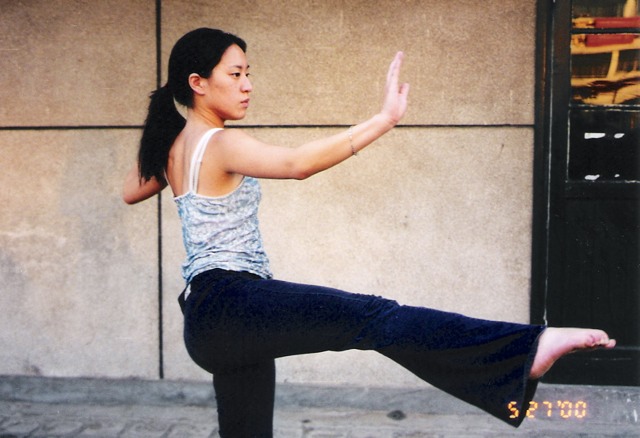
Beijing, China
I've just begun to explore the tai chi scene in Flushing: visiting my dad’s regular class on Northern Boulevard and an impromptu trio in Kissena Park, talking to a master named Teacher Du and some of his students (who include a number of cancer survivors), and meeting a turtle named Turtle, who sits on a sunny patch of grass while his owner practices under a willow tree, all of which will figure in future posts. But what keeps coming to mind right now are my own memories of studying tai chi in Beijing, more than ten years ago.
I was a complete newcomer to tai chi then, and my fellow students were, like me, language students in China, newly arrived from the US and the UK. For us, learning tai chi was akin to practicing our character strokes, eating local street food, sleeping on the wooden planks in our dorm, taking fifty-five hour train rides during school holidays to the southern provinces: one more way to immerse ourselves in the country we’d come to study.
Our teacher was a compact, wiry, baby-faced 25-year-old local who had us call him Willy. A nationally ranked kung-fu champion, he now made a living appearing as an extra in martial arts soap operas—and teaching clumsy foreigners, for whom nothing was too basic: how to bend our knees, how to balance, how to breathe.
I was the only person of Chinese descent in the class, and I seemed to have a little bit of innate facility. After a lifetime of straining to reach subway handrails, my height was an asset. Willy sometimes likened tai chi movements to a cat’s: tensile, artful, close to the earth, ready to spring. When he explained the proverbs behind certain movements—white cranes, horses’ manes, cloud hands, a needle at the bottom of the sea—my body seemed to comprehend.
As the weeks went by, most of my classmates fell away, and some mornings, it was just Willy and me, each a little embarrassed for the other, practicing in a little cracked courtyard where the university staff hung their laundry. One of my favorite ways to explore Beijing became watching groups of elderly men and women performing tai chi routines in perfect unison and silence, with exquisite slowness and grace, on random squares of pavement while the city roared around them.
By the end of the year, I felt I’d learned at least one routine, the 24-form, the way other kids learn to ride a bike: the body remembers. Back at my parents’ house in Flushing, I decided to teach it to my dad.
He was nearing sixty, and long days of driving a van and delivering florist supplies were taking a toll on his joints. No one in my family had ever been a regular practitioner of American-style exercise; running, hiking, swimming, weightlifting, not for fun but as a form of working out one’s body, had always seemed vaguely absurd to us. Tai chi, by contrast, now felt deeply elemental to me. A tradition that had passed from masters to schoolchildren for centuries, an ancestral thread that broke off at my father’s generation—until I traveled to Beijing and picked it up again.
My father had viewed my learning tai chi much the same way he’d viewed my desire to move to the country his family had fled a half-century before: a strange and somewhat amusing turn of events. When I offered to teach him what I knew, he scoffed. When I offered again, he chuckled. When I persisted, he sighed and followed me outside. He’s an amiable guy.
Our lessons lasted about two days. Maybe the process of translation that had transferred knowledge from Willy to me in Beijing got jumbled in my attempt to relay it to my father in our driveway. Maybe no daughter should try to teach her father anything. We didn’t argue, exactly; we just agreed to call it off.
In the years since, I’ve let my tai chi lapse. Meanwhile, my dad has become a total devotee. On his own, he signed up for lessons with Teacher Du. Two evenings a week, he meets with his classmates—all immigrants from China and Taiwan, mostly empty-nesters—to practice in a community center on Northern Boulevard. Early weekend mornings, he watches and sometimes joins the tai chi groups proliferating in the neighborhood parks. He has advanced way past the 24-form to the 42-form, the 58 form, forms that use swords and fans. He has helped recruit students, find new spaces, and organize exhibitions.
I knew all of this, how tai chi has become an organizing principle in his life, but it wasn’t until I visited his class the other night that I truly saw it: the fluidity of his movements, the particular thwack of his kick, the look of perfect concentration—and stillness—on his face. And I’m reminded of the obvious: I have a lot to learn from my dad.
Originally published at Open City: Blogging for Urban Change
